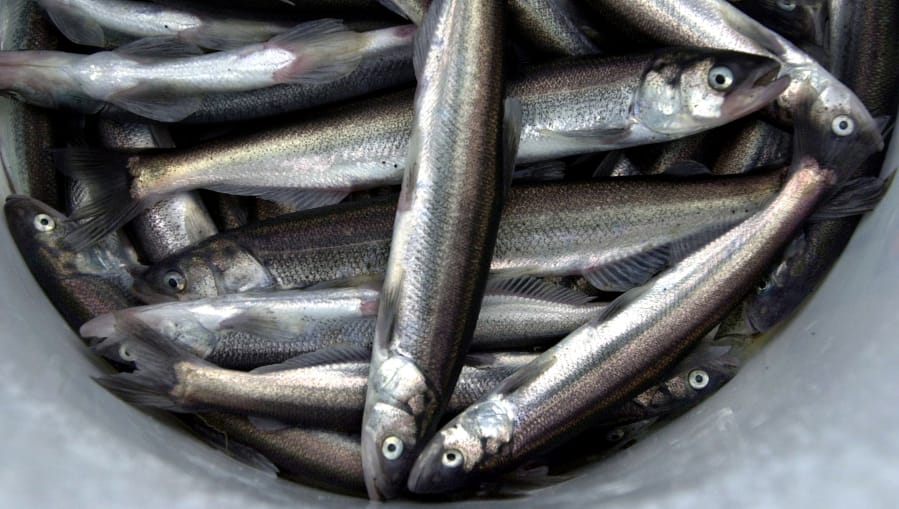LONGVIEW — As smelt dippers line the Cowlitz River on Tuesday, they will be participating in an activity that stretches far back in history, to the days when smelt used to be thick in local rivers.
Smelt runs in the Cowlitz River were once so abundant that Kelso called itself the “Smelt Capital of the World,” according to a January 2020 TDN article. Photos from the first half of the 20th century depict dipping boats brimming with the silvery fish, often loaded to the tops of their gunnels.
According to the Northwest Power and Conservation Council website, Longview used to organize smelt festivals and crown a “Smelt Queen,” with the winner getting a box of smelt.
The fish was an important food source for costal Indigenous peoples, who used to trade them inland.
Smelt runs have declined in recent decades.
Smelt is a thin, silvery fish species with a range from Long Beach, California to Chignik Lagoon, Alaska. The Columbia River has a specific kind of smelt, also called hooligan or eulachon. Columbia River smelt are listed as threatened under the Endangered Species Act, which is why recreational fishing is limited to years in which the run size is exceptionally large.
Smelt grow from an egg to a fish about eight or nine inches long and live for about five years. As smelt spawn on beaches with coarse sand or gravel, spawning habitat loss is one of the big problems facing the fish, according to the Washington Department of Fish and Wildlife, as “some spawning grounds are currently mere remnants of their original extent.”
Eulachon are an important food source for species from Chinook salmon to humpback whales, and as they enter the Columbia to spawn in the winter and early spring, the arrival of smelt was once the harbinger of spring Chinook salmon, according to the Northwest Power and Conservation Council.
A very oily fish, eulachon used to be dried and burned as candles, which is why they’re sometimes also called candlefish.
There’s a large commercial fishery for surf smelt. According to WDFW data, from 1938 to 2000, the annual mainstem Columbia River commercial landings averaged 400,000 pounds per year and the Cowlitz River commercial landings averaged about 1.2 million pounds per year, with equal recreational harvests.
In 2016, however, the recreational harvest was 141,000 pounds, and in 2018, just 110 pounds. The Columbia River Compact, which includes state Departments of Fish and Wildlife in Washington and Oregon, did not approve any commercial or recreational smelt fishing in 2019 due to the poor run in 2018.
Last year’s recreational fishery sent dippers home with an estimated 35,000 pounds of smelt during the first of two fishery openings last year, according to Laura Heironimus, WDFW’s Columbia River smelt spokesperson.
While Cowlitz River smelt abundance increased steadily from 2011 to 2016, peaking at an estimated 16.6 million pounds in 2014, runs tanked after that, according to the January 2020 TDN article.
Fish managers estimated that fewer than 400,000 pounds returned in 2018, making it the smallest run since the Columbia River Compact started estimating spawning stock biomass in 2010.
The Cowlitz Indian Tribe’s Natural Resources Department has been working on smelt recovery with WDFW, the Oregon Department of Fish and Wildlife and other partners since 2014, studying returns and the fish itself.
In 2007, the Cowlitz Indian Tribe petitioned for the species to be listed under the Endangered Species Act, and in 2010 the species was declared threatened.
In a report, “Cowlitz River Eulachon: Tribal Heritage and Spawning Stock Biomass 4th-year Results,” researchers wrote that “the protection, conservation and restoration work undertaken by the Cowlitz NRD is a modern expression of traditional Cowlitz culture, and highlights persistence of the deep relationship between the Cowlitz People and Eulachon People.”
There’s no one definitive reason why the runs have crashed lately. Some factors cited by WDFW are destruction of spawning grounds, overfishing, poor ocean survival and the May 18, 1980, eruption of Mount St. Helens, which caused the decades-long silting problem in the Cowlitz.
However, for the past two years recreational dippers have once again had a chance to fill their nets with the shiny, oily fish, and one thing that does abound is recipes for eating smelt.
In a 2001 TDN article, Daily News News Editor Nancy Edwards recalled dipping for smelt in the “lazy days of my childhood,” helping her family prepare the fish. Female smelt, skinny and mushy, were smoked or used as fertilizer in gardens, she wrote.
Males were fried. When smelt are fried, the bones become crisp and brittle and are eaten along with the fish, she said. Here’s one such recipe she shared: For more, see the 2001 TDN article “Smelts in your mouth.”
French-fried smelt: Take one pound of smelt and clean them. Soak in lemon juice for 10 to 15 minutes, enough juice to cover the fish. Beat one egg until foamy; add a 1/2 cup milk, 1/2 teaspoon salt, 1/2 cup flour and one teaspoon salad oil. Beat until smooth. Dip fish into batter and drop into hot fat, at 370 degrees F. Brown on one side, turn and brown on the other side. Lift out of hot fat and drain on paper towels. Serve with any good seafood sauce.



